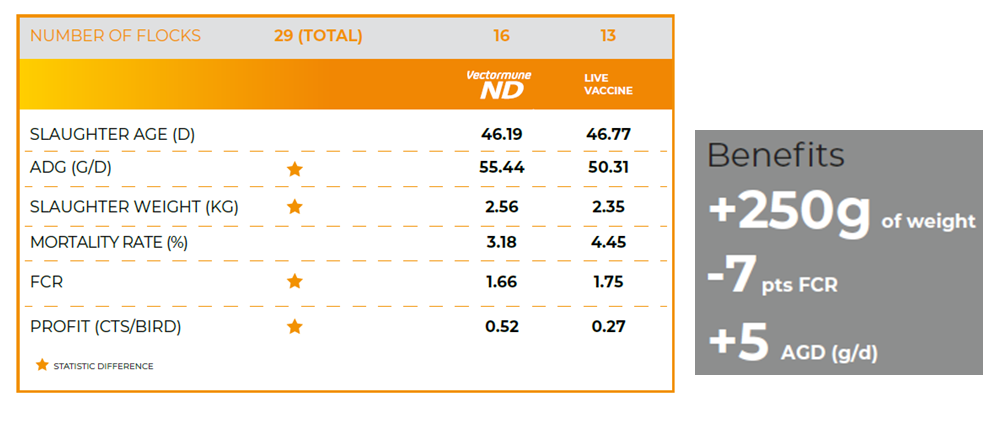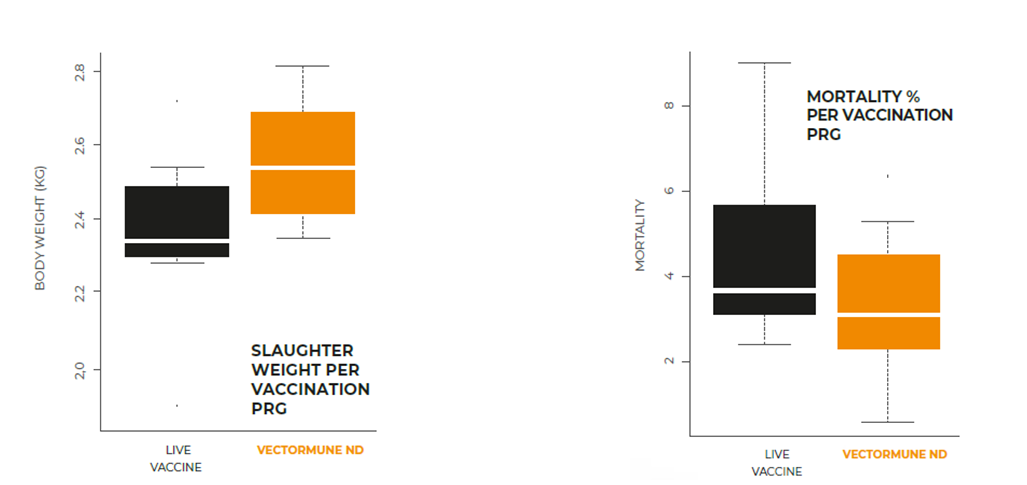



Why live ND vaccines are NOT good enough for low ND challenge countries?
Since it was first officially described in 1926, Newcastle disease (ND) has established as a major disease threat for commercial poultry including chickens, turkeys, quails, pheasants, as well as for hobby and zoo birds.
In low ND challenge countries, industrial chickens are often facing the uncontrolled circulation of lentogenic (vaccine) strains, especially in high densely populated poultry areas. As a result, they may show subtle to overt respiratory signs, because of the inflammation of the trachea. It may worsen in case of suboptimal husbandry conditions (too high stocking density, high ammonia level, wet litter, poor ventilation). As a result, flock uniformity will decrease, and secondary opportunistic respiratory infections (eg, E.coli) may arise with the need to apply antibiotic medication. Ultimately, slaughterhouse condemnations may increase due to excessive airsacculitis.
Economical Advantage
Production parameters differences measured in large scale field trials have demonstrated the consistency in ND protection with distinctive benefits of Vectormune® ND over the live ND conventional vaccination programs and to translate them into economic advantages.

Here, we present an example of a comparative field performance study involving 29 commercial broiler flocks from a country in Europe with low ND field virus challenge. Production performance parameters are presented in Table 1 indicating the statistical significance for the main parameters measured with the consequent economic benefits (Table 1).
Vaccination program in Live Vaccine group was B1 at day old age with spray and La Sota at 14 days of age with drinking water. In Vectormune® ND group the only ND vaccine was Vectormune® ND at the hatchery.

Why Live ND Vaccines are NOT the best for Low ND Challenge Countries?
Vaccination is an important part of the prevention program against ND. The essential required characteristic from an ideal vaccine is well balanced safety and efficacy.


Indeed, safety is the first priority for Low ND Pressure conditions. And here we see the key performance indicators of an ideal vaccine in terms of safety characteristics. Live ND vaccines are not meeting those expectations.
Vectormune® ND does not spread BUT LIVE ND VACCINES DO!
An example of a silent spread of lentogenic strains in ND-free regions such as Brazil is presented here. A broiler Integration in Brazil producing 7.7 million day-old chicks/month, with no history of ND vaccination conducted in the last 20 years was evaluated for the presence of a viral respiratory infection. Condemnations at this company, including airsacculitis were reaching around 0.5% monthly representing 38,500 chickens / month. A standard ND vaccination practice in Layer and breeder farms in the same area is to regularly vaccinate their flocks with Hitchner B1 live conventional vaccine.
Serological evaluation of broiler flocks showed high end-point serology at processing age at 42 days (ND Idexx ELISA). Results of the evaluation of the condemnations rate and medication costs for 2 consecutive broiler cycles without ND vaccination (298,000 chickens/ cycle; 8 houses) and after the administration of Vectormune® ND for one broiler cycle are shown in Figure 2. (A total of 285,000 chickens/cycle; same 8 houses).

Vectormune® ND prevented the uncontrolled circulation of lentogenic strains in ND-free areas, as evidenced by the lower Idexx serological titers; furthermore, it increased significantly the production performance of the flocks by improving respiratory health and by reducing the therapeutic use of antibiotics.
Vectormune® ND has no side effect!
SAFETY & EFFICACY OF VECTORMUNE® ND IN COMMERCIAL BROILERS IN EUROPE
In regions free of Newcastle disease like European countries, there are losses in broiler flocks’ performance due to the post-vaccination reactions caused by live attenuated ND vaccines. Spleen samples from 139 broiler flocks were collected at 4 weeks of age to verify the detection of the HVT vector of Vectormune® ND. Additionally, the production performance parameters from broiler flocks vaccinated with live ND vaccines has been compared with the production data from broiler flocks vaccinated with Vectormune® ND (Figure 3).


Blood samples were also collected at slaughter from a total of 339 broiler flocks before and after the use of Vectormune® ND vaccine and tested for antibody response to NDV using two commercial Elisa kits (IDVet specific for the rHVT-F insert and a conventional ND Elisa from Idexx).
Vectormune® ND is minimizing the transmission


Vectormune® ND is a strong tool to break the uncontrolled transmission of NDV among chickens in a house, in between houses in a farm, and ultimately among farms in a high densely populated poultry area. These graphs demonstrate that Vectormune® ND controls and prevents Newcastle Disease outbreaks despite of a different genotype between challenge strain and vaccine insert.
Summary
Newcastle disease continues to challenge poultry production operations even in Low ND challenge countries. With live ND vaccines it is not possible to keep the balance between safety and efficacy. There is a need to protect against lentogenic strains; however, on the other hand there is also a need to be safe! One option was live mild vaccines but there is a risk of virus circulation in the field and some post vaccination reactions, hence the therapeutic use of antibiotics. Other option was not to vaccinate but then welcoming all the risk of ND!
Vectormune® ND prevents the uncontrolled circulation of lentogenic NDV strains in ND-free areas, increasing significantly the performance of the flocks by improving respiratory health and by reducing the use of antibiotics as a direct consequence.
References available upon request









